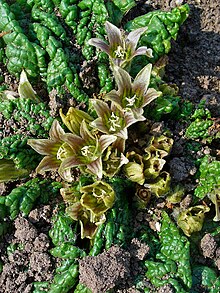Mandragoreae
| Mandragora | |
|---|---|
 |
|
| Mandragora officinarum | |
| Scientific classification | |
| Kingdom: | Plantae |
| Clade: | Angiosperms |
| Clade: | Eudicots |
| Clade: | Asterids |
| Order: | Solanales |
| Family: | Solanaceae |
| Subfamily: | Solanoideae |
| Genus: |
Mandragora L. |
| Species | |
Mandragora is a plant genus belonging to the nightshade family (Solanaceae). Members of the genus are known as mandrakes. There are between three and five species in the genus. The one or two species found around the Mediterranean constitute the mandrake of ancient writers such as Dioscorides. Two or three further species are found eastwards into China. All are perennial herbaceous plants, with large tap-roots and leaves in the form of a rosette. Individual flowers are bell-shaped, whitish through to violet, and are followed by yellow or orange berries.
Like many members of the Solanaceae, species of Mandragora contain highly biologically active alkaloids, making them poisonous, with a variety of effects, including hallucinations. Their roots in particular have a long use in traditional medicine. Mandrakes are involved in many myths and superstitions.
Species of Mandragora are perennial herbaceous plants. They have large vertical tap-roots, sometimes forked. Their stems are short or virtually absent. The leaves form a rosette at the base of the plant. The flowers are sometimes borne on a short stalk (scape), and are solitary, with whorls of five parts. The sepals are joined at the base, as are the petals, both in the shape of a lobed bell. The stamens are shorter than the petals, joined to the floral tube towards the base. The ovary has two chambers (locules). After fertilization, a yellow or orange fruit forms (botanically a berry).
...
Wikipedia
